Publications
Peer-reviewed publications
2025
-
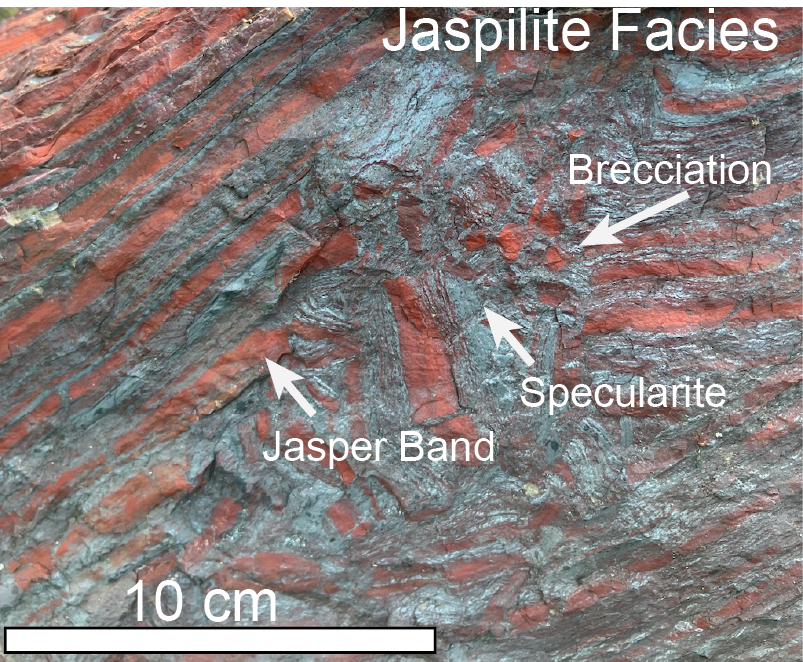 Evolution of iron formation to ore during Ediacaran to early Paleozoic tectonic stabilityFuentes, Anthony J., Courtney-Davies, Liam, Flowers, Rebecca, Zhang, Yiming, and Swanson-Hysell, NicholasEarth and Planetary Science Letters Dec 2025
Evolution of iron formation to ore during Ediacaran to early Paleozoic tectonic stabilityFuentes, Anthony J., Courtney-Davies, Liam, Flowers, Rebecca, Zhang, Yiming, and Swanson-Hysell, NicholasEarth and Planetary Science Letters Dec 2025 -
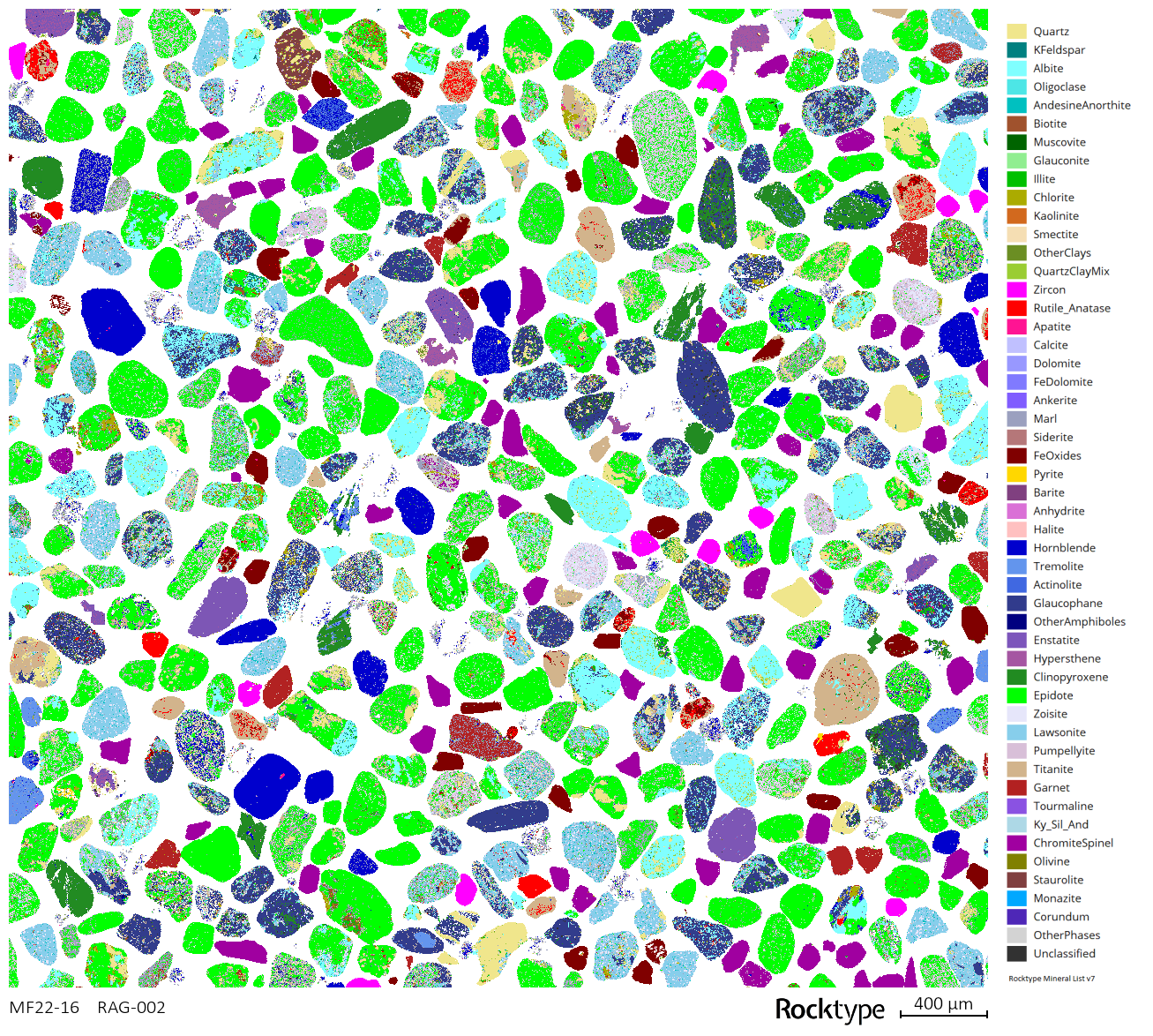 The stratigraphic record of the arrival of the Sacramento and San Joaquin rivers to the California coast, U.S.A.Kahn, Leah X., Zhang, Yiming, Finnegan, Seth, Hodgin, Eben B., and Swanson-Hysell, Nicholas L.Journal of Sedimentary Research Oct 2025
The stratigraphic record of the arrival of the Sacramento and San Joaquin rivers to the California coast, U.S.A.Kahn, Leah X., Zhang, Yiming, Finnegan, Seth, Hodgin, Eben B., and Swanson-Hysell, Nicholas L.Journal of Sedimentary Research Oct 2025@article{Kahn2025a, author = {Kahn, Leah X. and Zhang, Yiming and Finnegan, Seth and Hodgin, Eben B. and Swanson-Hysell, Nicholas L.}, date-added = {2025-10-01 20:56:41 -0500}, date-modified = {2025-10-01 21:00:43 -0500}, doi = {10.2110/jsr.2024.153}, issn = {1527-1404}, journal = {Journal of Sedimentary Research}, month = oct, number = {5}, pages = {946--958}, publisher = {Society for Sedimentary Geology}, title = {The stratigraphic record of the arrival of the Sacramento and San Joaquin rivers to the California coast, U.S.A.}, url = {http://dx.doi.org/10.2110/jsr.2024.153}, volume = {95}, year = {2025}, bdsk-url-1 = {http://dx.doi.org/10.2110/jsr.2024.153} } -
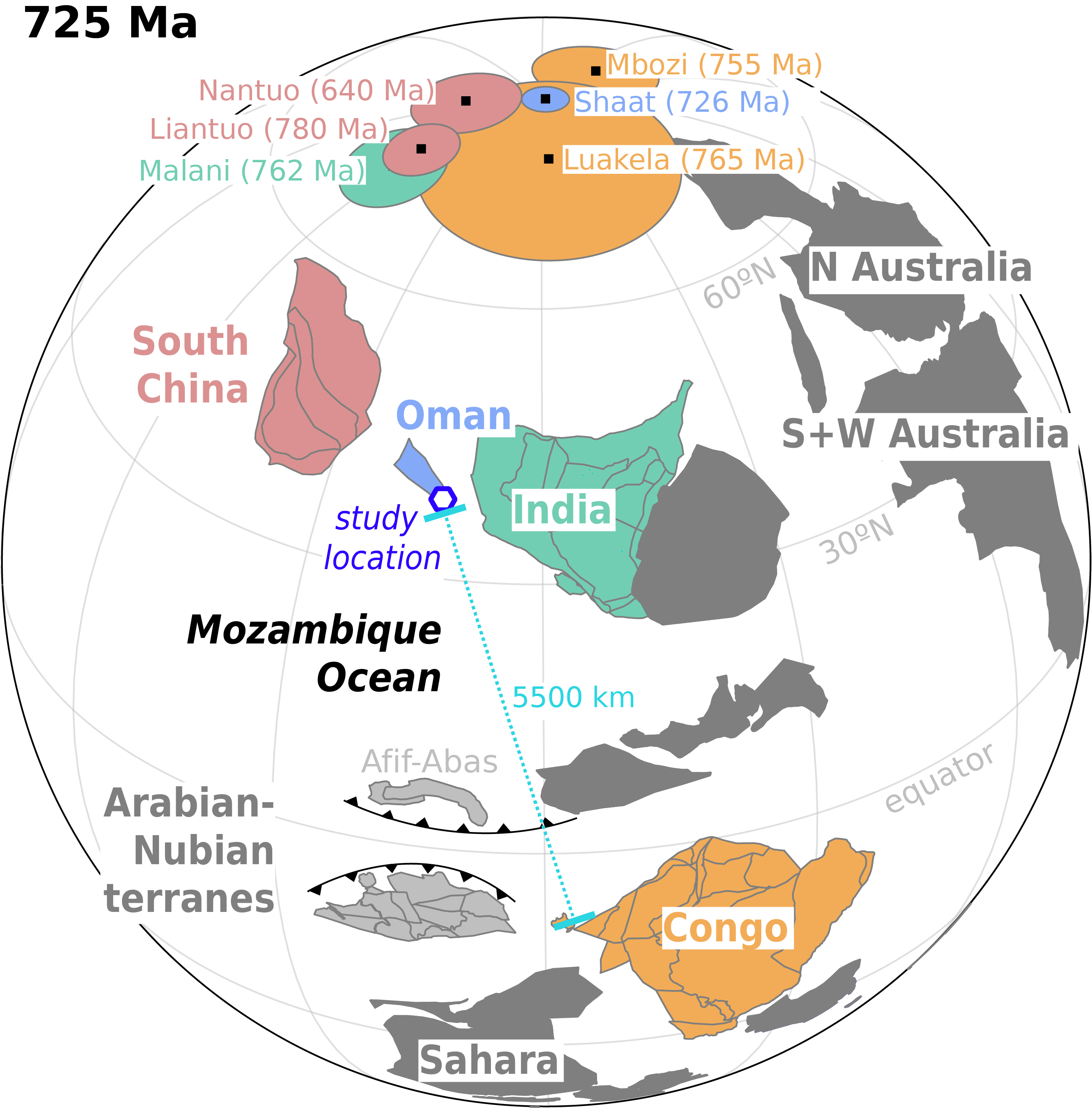 Oman was on the northern margin of a wide late Tonian Mozambique OceanSwanson-Hysell, Nicholas L., Zhang, Yiming, Macdonald, Francis A., Koran, Isabel, Tasistro-Hart, Adrian R., and Jay, Annabel F.Geology Oct 2025
Oman was on the northern margin of a wide late Tonian Mozambique OceanSwanson-Hysell, Nicholas L., Zhang, Yiming, Macdonald, Francis A., Koran, Isabel, Tasistro-Hart, Adrian R., and Jay, Annabel F.Geology Oct 2025The closure of the Mozambique Ocean defines the final assembly of the megacontinent Gondwana and is associated with a vast region of crustal growth in the Arabian-Nubian Shield. Despite this central paleogeographic position, there are few constraints on the posi- tion of terranes within and bounding the Mozambique Ocean. We report paleomagnetic data from ca. 726 Ma dikes exposed in southern Oman. Well-resolved magnetite magnetization is constrained to be primary by a conglomerate test on mafic clasts within overlying Cryogenian diamictite. The resulting paleomagnetic pole indicates that Oman was at a paleolatitude of 37\pm2.5\,^∘N and was rotated ∼80\,^∘ counterclockwise from its present-day orientation. This position is consistent with Oman forming a contiguous plate with the India and South China cratons on the northern margin of the Mozambique Ocean in a distinct tectonic domain from Arabian-Nubian arcs to the south. This position reveals an ∼5500-km-wide oceanic realm prior to subsequent closure that resulted in a major zone of Neoproterozoic crustal growth.
-
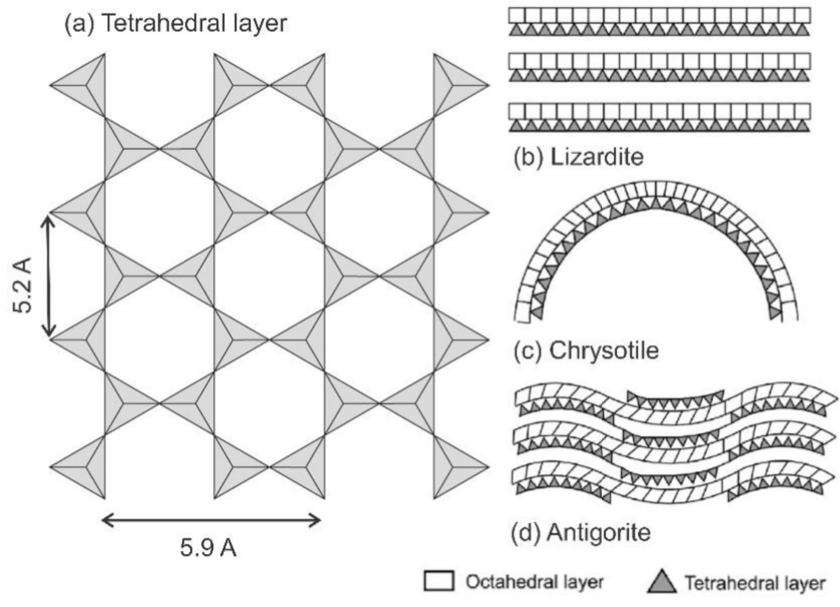 Exploring microstructures and anisotropies of serpentinitesWenk, Hans-Rudolf, Kattemalavadi, Amartya, Zhang, Yiming, Kennedy, Ellis R., and Borkiewicz, OlafContributions to Mineralogy and Petrology Oct 2025
Exploring microstructures and anisotropies of serpentinitesWenk, Hans-Rudolf, Kattemalavadi, Amartya, Zhang, Yiming, Kennedy, Ellis R., and Borkiewicz, OlafContributions to Mineralogy and Petrology Oct 2025Serpentine minerals have received a lot of attention because of their unique crystal structures, their wide occurrence in orogenic belts and their potential role in contributing seismic anisotropy in subducting slabs. Several studies have investigated crystal preferred orientation (CPO) in high temperature antigorite serpentinites from Japan, the Alps, Spain, Cuba and Tibet, documenting significant crystal alignment. However, only a limited number of lower grade serpentines have been explored to date. Mainly because of submicroscopic microstructural heterogeneities CPO cannot be measured with conventional methods such as optical microscopy and EBSD. In this study 15 serpentinites from different tectonic settings in California, the Central Alps and Northern Spain have been investigated, mainly with high energy synchrotron X-ray diffraction, to quantify bulk crystal alignment. We find that CPO is strong on sheared surfaces of fractured blocks and secondary veins but the bulk of most serpentinite samples, except high-grade recrystallized antigorite serpentinite, show only weak crystal alignment. Correspondingly calculated seismic anisotropy based on CPO is not very significant. This is supported by very heterogeneous microstructures as documented with SEM and TEM analyses.
@article{Wenk2025a, author = {Wenk, Hans-Rudolf and Kattemalavadi, Amartya and Zhang, Yiming and Kennedy, Ellis R. and Borkiewicz, Olaf}, date = {2025/03/03}, date-added = {2025-03-04 10:27:58 -0600}, date-modified = {2025-03-04 12:06:45 -0600}, doi = {10.1007/s00410-025-02209-5}, id = {Wenk2025}, isbn = {1432-0967}, journal = {Contributions to Mineralogy and Petrology}, number = {3}, pages = {23}, title = {Exploring microstructures and anisotropies of serpentinites}, url = {https://doi.org/10.1007/s00410-025-02209-5}, volume = {180}, year = {2025}, bdsk-url-1 = {https://doi.org/10.1007/s00410-025-02209-5} }
2024
-
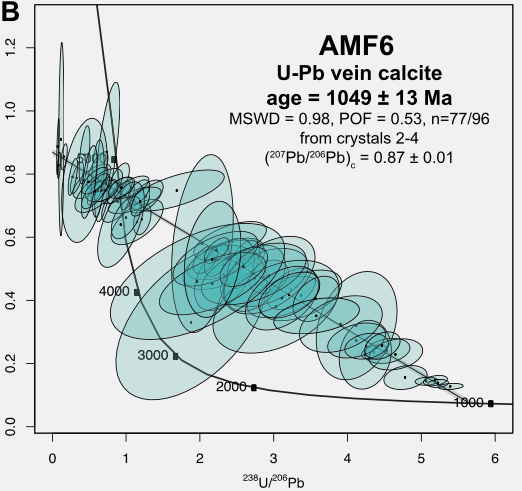 One billion years of stability in the North American midcontinent following two-stage Grenvillian structural inversionHodgin, Eben B., Swanson-Hysell, Nicholas L., Kylander-Clark, Andrew R. C., Turner, Andrew C., Stolper, Daniel A., Ibarra, Daniel E., Schmitz, Mark D., Zhang, Yiming, Fairchild, Luke M., and Fuentes, Anthony J.Tectonics Oct 2024
One billion years of stability in the North American midcontinent following two-stage Grenvillian structural inversionHodgin, Eben B., Swanson-Hysell, Nicholas L., Kylander-Clark, Andrew R. C., Turner, Andrew C., Stolper, Daniel A., Ibarra, Daniel E., Schmitz, Mark D., Zhang, Yiming, Fairchild, Luke M., and Fuentes, Anthony J.Tectonics Oct 2024 -
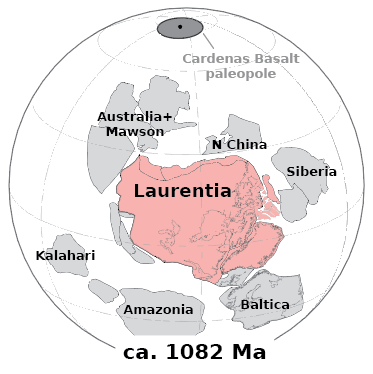 Paleomagnetic records from pulsed magmatism in the southwestern Laurentia large igneous province and Cardenas Basalt support rapid late Mesoproterozoic plate motionZhang, Yiming, Anderson, Nicolas S., Mohr, Michael T., Nelson, Lyle L., Macdonald, Francis A., Schmitz, Mark D., Thurston, Olivia G., Guenthner, William R., Karlstrom, Karl E., and Swanson-Hysell, Nicholas L.Journal of Geophysical Research: Solid Earth Oct 2024
Paleomagnetic records from pulsed magmatism in the southwestern Laurentia large igneous province and Cardenas Basalt support rapid late Mesoproterozoic plate motionZhang, Yiming, Anderson, Nicolas S., Mohr, Michael T., Nelson, Lyle L., Macdonald, Francis A., Schmitz, Mark D., Thurston, Olivia G., Guenthner, William R., Karlstrom, Karl E., and Swanson-Hysell, Nicholas L.Journal of Geophysical Research: Solid Earth Oct 2024@article{Zhang2024d, author = {Zhang, Yiming and Anderson, Nicolas S. and Mohr, Michael T. and Nelson, Lyle L. and Macdonald, Francis A. and Schmitz, Mark D. and Thurston, Olivia G. and Guenthner, William R. and Karlstrom, Karl E. and Swanson-Hysell, Nicholas L.}, date-added = {2024-10-24 19:42:05 -0500}, date-modified = {2025-03-04 12:05:05 -0600}, doi = {10.1029/2024jb029036}, issn = {2169-9356}, journal = {Journal of Geophysical Research: Solid Earth}, number = {10}, publisher = {American Geophysical Union (AGU)}, volume = {129}, year = {2024}, bdsk-file-1 = {YnBsaXN0MDDSAQIDBFxyZWxhdGl2ZVBhdGhYYm9va21hcmtfED4uLi8uLi9saXRlcmF0dXJlL1poYW5nMjAyNGRQYWxlb21hZ25ldGljIFJlY29yZHMgRnJvbSBQdWxhLnBkZk8RBFBib29rUAQAAAAABBAwAAAAAAAAAAAAAAAAAAAAAAAAAAAAAAAAAAAAAAAAAAAAAABAAwAABQAAAAEBAABVc2VycwAAAAsAAAABAQAAeWltaW5nemhhbmcABgAAAAEBAABHaXRodWIAAAoAAAABAQAAbGl0ZXJhdHVyZQAALQAAAAEBAABaaGFuZzIwMjRkUGFsZW9tYWduZXRpYyBSZWNvcmRzIEZyb20gUHVsYS5wZGYAAAAUAAAAAQYAAAQAAAAUAAAAKAAAADgAAABMAAAACAAAAAQDAAAiQgAAAAAAAAgAAAAEAwAAmF4AAAAAAAAIAAAABAMAACP4CgAAAAAACAAAAAQDAAD2xgwAAAAAAAgAAAAEAwAAXU8QAAAAAAAUAAAAAQYAAKAAAACwAAAAwAAAANAAAADgAAAACAAAAAAEAABBxmIIRAAAABgAAAABAgAAAQAAAAAAAAAPAAAAAAAAAAAAAAAAAAAACAAAAAQDAAADAAAAAAAAAAQAAAADAwAA9QEAAAgAAAABCQAAZmlsZTovLy8MAAAAAQEAAE1hY2ludG9zaCBIRAgAAAAEAwAAAJCClucAAAAIAAAAAAQAAEHHKISGgAAAJAAAAAEBAAA0OUQ2RTEwMy0yMUUzLTQ4RjYtQTFBRi1DNDE2NkY3NzU0OEUYAAAAAQIAAIEAAAABAAAA7xMAAAEAAAAAAAAAAAAAAAEAAAABAQAALwAAAAAAAAABBQAABAEAAAECAAA2OTIxZTU1OGMyMDU2YzE5ZDU4NmMxN2RmNjYyODNiNTQwNDk0YjQ0OTQxMWY1OGNhNzBiOTUxNmUxZjYzYzljOzAwOzAwMDAwMDAwOzAwMDAwMDAwOzAwMDAwMDAwOzAwMDAwMDAwMDAwMDAwMjA7Y29tLmFwcGxlLmFwcC1zYW5kYm94LnJlYWQtd3JpdGU7MDE7MDEwMDAwMGQ7MDAwMDAwMDAwMDEwNGY1ZDswMTsvdXNlcnMveWltaW5nemhhbmcvZ2l0aHViL2xpdGVyYXR1cmUvemhhbmcyMDI0ZHBhbGVvbWFnbmV0aWMgcmVjb3JkcyBmcm9tIHB1bGEucGRmAC8AAAABAQAATlNVUkxCb29rbWFya1F1YXJhbnRpbmVNb3VudGVkTmV0d29ya1ZvbHVtZXNLZXkA2AAAAP7///8BAAAAAAAAABEAAAAEEAAAhAAAAAAAAAAFEAAA8AAAAAAAAAAQEAAAHAEAAAAAAABAEAAADAEAAAAAAAACIAAA6AEAAAAAAAAFIAAAWAEAAAAAAAAQIAAAaAEAAAAAAAARIAAAnAEAAAAAAAASIAAAfAEAAAAAAAATIAAAjAEAAAAAAAAgIAAAyAEAAAAAAAAwIAAA9AEAAAAAAAABwAAAPAEAAAAAAAARwAAAFAAAAAAAAAASwAAATAEAAAAAAACA8AAA/AEAAAAAAAAIAwCA9AEAAAAAAAAACAANABoAIwBkAAAAAAAAAgEAAAAAAAAABQAAAAAAAAAAAAAAAAAABLg=}, bdsk-url-1 = {http://dx.doi.org/10.1029/2024JB029036} } -
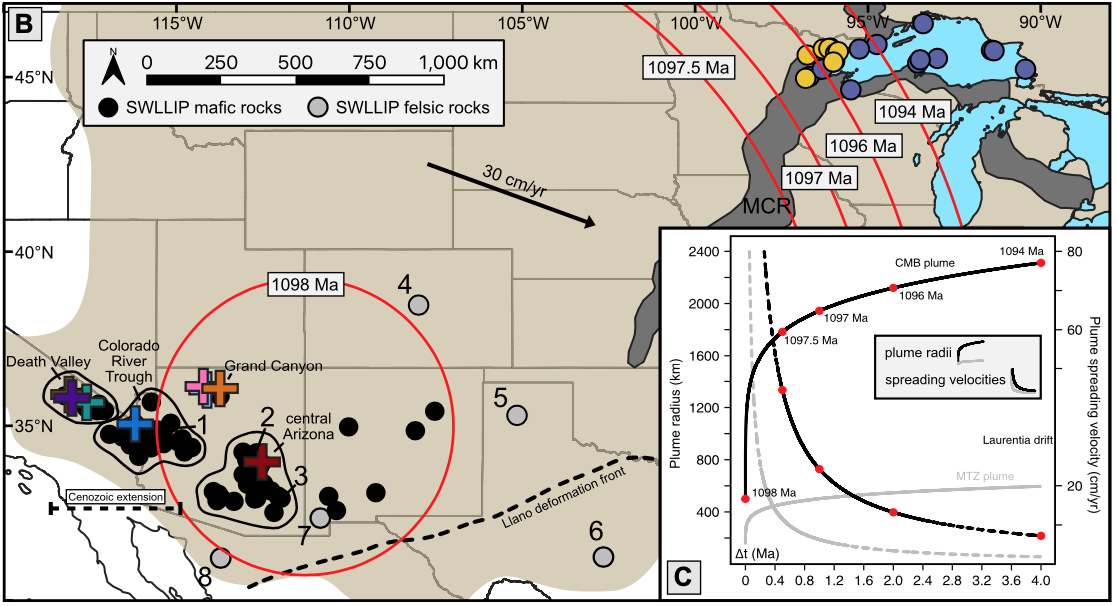 High-precision U-Pb geochronology links magmatism in the Southwestern Laurentia large igneous province and Midcontinent RiftMohr, M.T., Schmitz, M.D., Swanson-Hysell, N.L., Karlstrom, K.E., Macdonald, F.A., Holland, M.E., Zhang, Y., and Anderson, N.S.Geology Oct 2024
High-precision U-Pb geochronology links magmatism in the Southwestern Laurentia large igneous province and Midcontinent RiftMohr, M.T., Schmitz, M.D., Swanson-Hysell, N.L., Karlstrom, K.E., Macdonald, F.A., Holland, M.E., Zhang, Y., and Anderson, N.S.Geology Oct 2024@article{Mohr2024a, author = {Mohr, M.T. and Schmitz, M.D. and Swanson-Hysell, N.L. and Karlstrom, K.E. and Macdonald, F.A. and Holland, M.E. and Zhang, Y. and Anderson, N.S.}, date-added = {2024-02-07 17:32:04 -0700}, date-modified = {2025-03-04 12:08:52 -0600}, doi = {10.1130/g51786.1}, issn = {1943-2682}, journal = {Geology}, publisher = {Geological Society of America}, title = {{High-precision U-Pb geochronology links magmatism in the Southwestern Laurentia large igneous province and Midcontinent Rift}}, year = {2024}, bdsk-file-1 = {YnBsaXN0MDDSAQIDBFxyZWxhdGl2ZVBhdGhYYm9va21hcmtfED0uLi8uLi9saXRlcmF0dXJlL01vaHIyMDI0YUhpZ2gtcHJlY2lzaW9uIFUtUGIgZ2VvY2hyb25vbGEucGRmTxEEiGJvb2uIBAAAAAAEEDAAAAAAAAAAAAAAAAAAAAAAAAAAAAAAAAAAAAAAAAAAAAAAAGwDAAAFAAAAAQEAAFVzZXJzAAAACwAAAAEBAAB5aW1pbmd6aGFuZwAGAAAAAQEAAEdpdGh1YgAACgAAAAEBAABsaXRlcmF0dXJlAAAsAAAAAQEAAE1vaHIyMDI0YUhpZ2gtcHJlY2lzaW9uIFUtUGIgZ2VvY2hyb25vbGEucGRmFAAAAAEGAAAEAAAAFAAAACgAAAA4AAAATAAAAAgAAAAEAwAAIkIAAAAAAAAIAAAABAMAAJheAAAAAAAACAAAAAQDAAAj+AoAAAAAAAgAAAAEAwAA9sYMAAAAAAAIAAAABAMAACOqVQIAAAAAFAAAAAEGAACcAAAArAAAALwAAADMAAAA3AAAAAgAAAAABAAAQcWtIRyAAAAYAAAAAQIAAAEAAAAAAAAADwAAAAAAAAAAAAAAAAAAAAgAAAAEAwAAAwAAAAAAAAAEAAAAAwMAAPUBAAAIAAAAAQkAAGZpbGU6Ly8vDAAAAAEBAABNYWNpbnRvc2ggSEQIAAAABAMAAACQgpbnAAAACAAAAAAEAABBxyiEhoAAACQAAAABAQAANDlENkUxMDMtMjFFMy00OEY2LUExQUYtQzQxNjZGNzc1NDhFGAAAAAECAACBAAAAAQAAAO8TAAABAAAAAAAAAAAAAAABAAAAAQEAAC8AAAAAAAAAAQUAABoAAAABAQAATlNVUkxEb2N1bWVudElkZW50aWZpZXJLZXkAAAQAAAADAwAAocoBAAMBAAABAgAAZGYzOTRlYjQyZjBkNGFlZjA5NzBiYWQwZGEwNjU5NTk5YzdkNGQ5YmQ2ZjcwYTEzN2RhZmU2MWQyZDNlOTFkZDswMDswMDAwMDAwMDswMDAwMDAwMDswMDAwMDAwMDswMDAwMDAwMDAwMDAwMDIwO2NvbS5hcHBsZS5hcHAtc2FuZGJveC5yZWFkLXdyaXRlOzAxOzAxMDAwMDBkOzAwMDAwMDAwMDI1NWFhMjM7MDE7L3VzZXJzL3lpbWluZ3poYW5nL2dpdGh1Yi9saXRlcmF0dXJlL21vaHIyMDI0YWhpZ2gtcHJlY2lzaW9uIHUtcGIgZ2VvY2hyb25vbGEucGRmAAAvAAAAAQEAAE5TVVJMQm9va21hcmtRdWFyYW50aW5lTW91bnRlZE5ldHdvcmtWb2x1bWVzS2V5AOQAAAD+////AQAAAAAAAAASAAAABBAAAIAAAAAAAAAABRAAAOwAAAAAAAAAEBAAABgBAAAAAAAAQBAAAAgBAAAAAAAAAiAAAOQBAAAAAAAABSAAAFQBAAAAAAAAECAAAGQBAAAAAAAAESAAAJgBAAAAAAAAEiAAAHgBAAAAAAAAEyAAAIgBAAAAAAAAICAAAMQBAAAAAAAAMCAAAPABAAAAAAAAAcAAADgBAAAAAAAAEcAAABQAAAAAAAAAEsAAAEgBAAAAAAAAgPAAACgCAAAAAAAA+AEAgBwCAAAAAAAANAMAgPABAAAAAAAAAAgADQAaACMAYwAAAAAAAAIBAAAAAAAAAAUAAAAAAAAAAAAAAAAAAATv}, bdsk-url-1 = {http://dx.doi.org/10.1130/G51786.1} } -
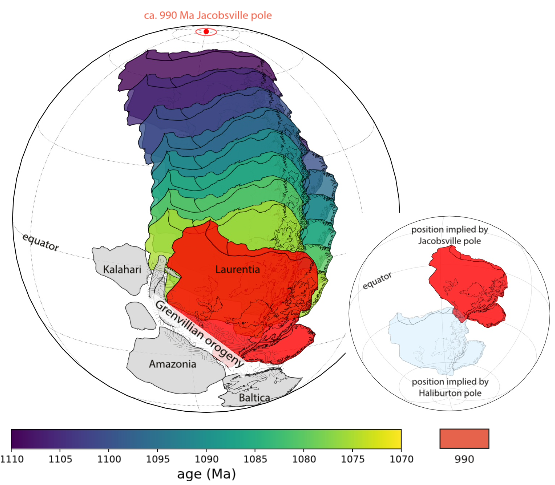 Tracking Rodinia Into the Neoproterozoic: New Paleomagnetic Constraints From the Jacobsville FormationZhang, Yiming, Hodgin, Eben B., Alemu, Tadesse, Pierce, James, Fuentes, Anthony, and Swanson-Hysell, Nicholas L.Tectonics Oct 2024
Tracking Rodinia Into the Neoproterozoic: New Paleomagnetic Constraints From the Jacobsville FormationZhang, Yiming, Hodgin, Eben B., Alemu, Tadesse, Pierce, James, Fuentes, Anthony, and Swanson-Hysell, Nicholas L.Tectonics Oct 2024Abstract The paleogeography of Laurentia throughout the Neoproterozoic is critical for reconstructing global paleogeography due to its central position in the supercontinent Rodinia. We develop a new paleomagnetic pole from red siltstones and fine-grained sandstones of the early Neoproterozoic Jacobsville Formation which is now constrained to be ca. 990 Ma in age. High-resolution thermal demagnetization experiments resolve detrital remanent magnetizations held by hematite. These directions were reoriented within siltstone intraclasts and pass intraformational conglomerate tests—giving confidence that the magnetization is detrital and primary. An inclination-corrected mean paleomagnetic pole position for the Jacobsville Formation indicates that Laurentia’s motion slowed down significantly following the onset of the Grenvillian orogeny. Prior rapid plate motion associated with closure of the Unimos Ocean between 1,110 and 1,090 Ma transitioned to slow drift of Laurentia across the equator in the late Mesoproterozoic to early Neoproterozoic. We interpret the distinct position of this well-dated pole from those in the Grenville orogen that have been assigned a similar age to indicate that the ages of the poles associated with the Grenville Loop likely need to be revised to be younger due to prolonged exhumation.
@article{Zhang2024a, author = {Zhang, Yiming and Hodgin, Eben B. and Alemu, Tadesse and Pierce, James and Fuentes, Anthony and Swanson-Hysell, Nicholas L.}, date-added = {2024-02-07 16:57:58 -0700}, date-modified = {2025-03-04 12:05:58 -0600}, doi = {https://doi.org/10.1029/2023TC007866}, journal = {Tectonics}, keywords = {Rodinia, laurentia, proterozoic, Grenville, paleomagnetism, paleogeography}, note = {e2023TC007866 2023TC007866}, number = {2}, pages = {e2023TC007866}, title = {Tracking Rodinia Into the Neoproterozoic: New Paleomagnetic Constraints From the Jacobsville Formation}, url = {https://agupubs.onlinelibrary.wiley.com/doi/abs/10.1029/2023TC007866}, volume = {43}, year = {2024}, bdsk-url-1 = {https://agupubs.onlinelibrary.wiley.com/doi/abs/10.1029/2023TC007866}, bdsk-url-2 = {https://doi.org/10.1029/2023TC007866} }
2023
-
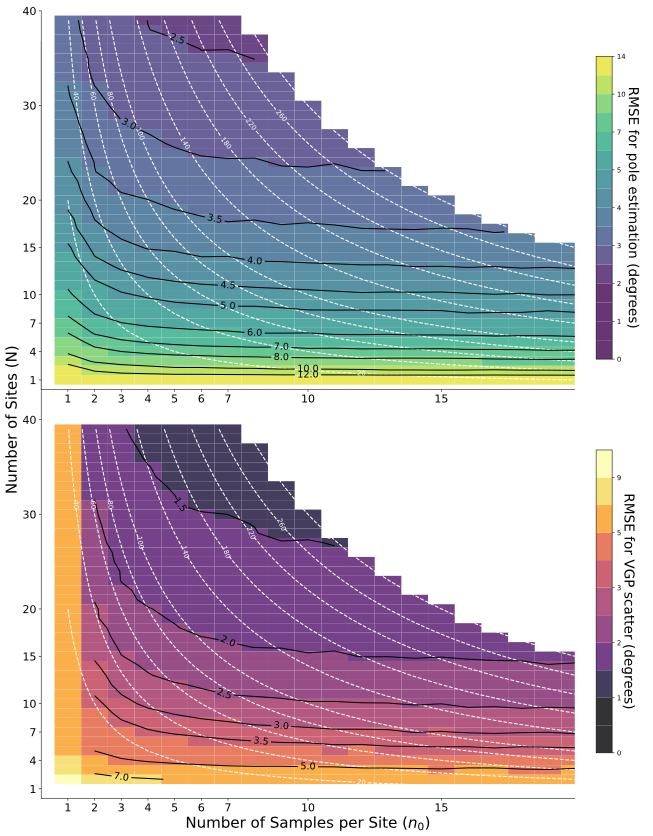 Quantitative Analysis of Paleomagnetic Sampling StrategiesSapienza, F., Gallo, L. C., Zhang, Yiming, Vaes, B., Domeier, M., and Swanson-Hysell, N. L.Journal of Geophysical Research: Solid Earth Sep 2023
Quantitative Analysis of Paleomagnetic Sampling StrategiesSapienza, F., Gallo, L. C., Zhang, Yiming, Vaes, B., Domeier, M., and Swanson-Hysell, N. L.Journal of Geophysical Research: Solid Earth Sep 2023@article{Sapienza2023a, author = {Sapienza, F. and Gallo, L. C. and Zhang, Yiming and Vaes, B. and Domeier, M. and Swanson-Hysell, N. L.}, date-added = {2023-11-07 20:43:44 -0800}, date-modified = {2025-03-04 12:08:05 -0600}, doi = {10.1029/2023jb027211}, journal = {Journal of Geophysical Research: Solid Earth}, month = sep, publisher = {American Geophysical Union ({AGU})}, title = {Quantitative Analysis of Paleomagnetic Sampling Strategies}, url = {https://doi.org/10.1029%2F2023jb027211}, year = {2023}, bdsk-url-1 = {https://doi.org/10.1029%2F2023jb027211}, bdsk-url-2 = {https://doi.org/10.1029/2023jb027211} } -
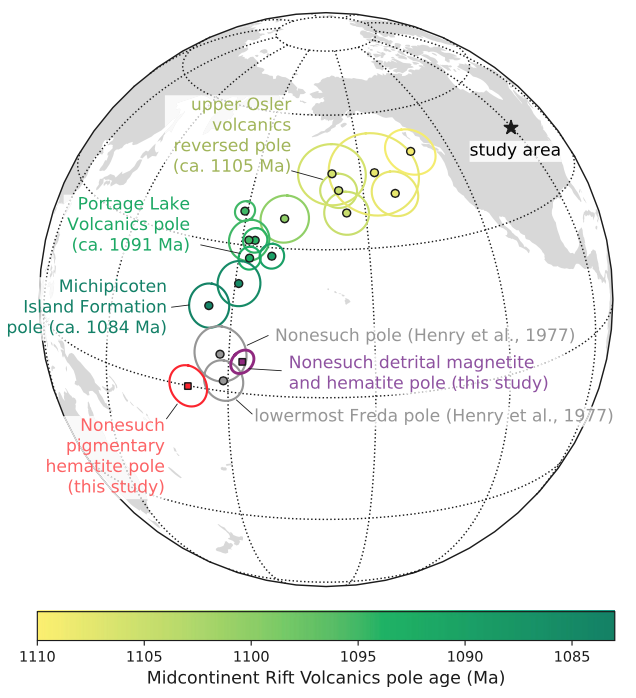 Reconstructing the paleoenvironment of an oxygenated Mesoproterozoic shoreline and its record of lifeSlotznick, Sarah P., Swanson-Hysell, Nicholas L., Zhang, Yiming, Clayton, Katherine E., Wellman, Charles H., Tosca, Nicholas J., and Strother, Paul K.GSA Bulletin Sep 2023
Reconstructing the paleoenvironment of an oxygenated Mesoproterozoic shoreline and its record of lifeSlotznick, Sarah P., Swanson-Hysell, Nicholas L., Zhang, Yiming, Clayton, Katherine E., Wellman, Charles H., Tosca, Nicholas J., and Strother, Paul K.GSA Bulletin Sep 2023@article{Slotznick2023a, author = {Slotznick, Sarah P. and Swanson-Hysell, Nicholas L. and Zhang, Yiming and Clayton, Katherine E. and Wellman, Charles H. and Tosca, Nicholas J. and Strother, Paul K.}, date-added = {2023-06-10 12:24:24 -0700}, date-modified = {2025-03-04 12:07:55 -0600}, doi = {10.1130/B36634.1}, journal = {GSA Bulletin}, title = {{Reconstructing the paleoenvironment of an oxygenated Mesoproterozoic shoreline and its record of life}}, year = {2023}, bdsk-url-1 = {https://doi.org/10.1130/B36634.1} } -
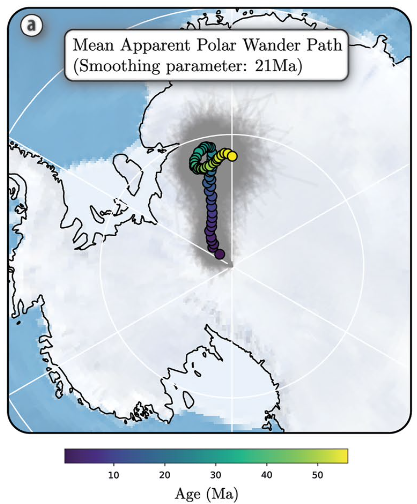 Embracing Uncertainty to Resolve Polar Wander: A Case Study of Cenozoic North AmericaGallo, L. C., Domeier, M., Sapienza, F., Swanson-Hysell, N. L., Vaes, B., Zhang, Yiming, Arnould, M., Eyster, A., Gürer, D., Király, Á., Robert, B., Rolf, T., Shephard, G., and Boon, A.Geophysical Research Letters Sep 2023
Embracing Uncertainty to Resolve Polar Wander: A Case Study of Cenozoic North AmericaGallo, L. C., Domeier, M., Sapienza, F., Swanson-Hysell, N. L., Vaes, B., Zhang, Yiming, Arnould, M., Eyster, A., Gürer, D., Király, Á., Robert, B., Rolf, T., Shephard, G., and Boon, A.Geophysical Research Letters Sep 2023Abstract Our understanding of Earth’s paleogeography relies heavily on paleomagnetic apparent polar wander paths (APWPs), which represent the time-dependent position of Earth’s spin axis relative to a given block of lithosphere. However, conventional approaches to APWP construction have significant limitations. First, the paleomagnetic record contains substantial noise that is not integrated into APWPs. Second, parametric assumptions are adopted to represent spatial and temporal uncertainties even where the underlying data do not conform to the assumed distributions. The consequences of these limitations remain largely unknown. Here, we address these challenges with a bottom-up Monte Carlo uncertainty propagation scheme that operates on site-level paleomagnetic data. To demonstrate our methodology, we present an extensive compilation of site-level Cenozoic paleomagnetic data from North America, which we use to generate a high-resolution APWP. Our results demonstrate that even in the presence of substantial noise, polar wandering can be assessed with unprecedented temporal and spatial resolution.
@article{Gallo2023a, author = {Gallo, L. C. and Domeier, M. and Sapienza, F. and Swanson-Hysell, N. L. and Vaes, B. and Zhang, Yiming and Arnould, M. and Eyster, A. and G{\"u}rer, D. and Kir{\'a}ly, {\'A}. and Robert, B. and Rolf, T. and Shephard, G. and van der Boon, A.}, date-added = {2023-06-10 12:24:16 -0700}, date-modified = {2025-03-04 12:09:39 -0600}, doi = {https://doi.org/10.1029/2023GL103436}, journal = {Geophysical Research Letters}, keywords = {paleomagnetism, polar wander, uncertainty quantification}, note = {e2023GL103436 2023GL103436}, number = {11}, pages = {e2023GL103436}, title = {Embracing Uncertainty to Resolve Polar Wander: A Case Study of Cenozoic North America}, volume = {50}, year = {2023}, bdsk-file-1 = {YnBsaXN0MDDSAQIDBFxyZWxhdGl2ZVBhdGhYYm9va21hcmtfED4uLi8uLi9saXRlcmF0dXJlL0dhbGxvMjAyM2FFbWJyYWNpbmcgVW5jZXJ0YWludHkgdG8gUmVzb2xhLnBkZk8RBFBib29rUAQAAAAABBAwAAAAAAAAAAAAAAAAAAAAAAAAAAAAAAAAAAAAAAAAAAAAAABAAwAABQAAAAEBAABVc2VycwAAAAsAAAABAQAAeWltaW5nemhhbmcABgAAAAEBAABHaXRodWIAAAoAAAABAQAAbGl0ZXJhdHVyZQAALQAAAAEBAABHYWxsbzIwMjNhRW1icmFjaW5nIFVuY2VydGFpbnR5IHRvIFJlc29sYS5wZGYAAAAUAAAAAQYAAAQAAAAUAAAAKAAAADgAAABMAAAACAAAAAQDAAAiQgAAAAAAAAgAAAAEAwAAmF4AAAAAAAAIAAAABAMAACP4CgAAAAAACAAAAAQDAAD2xgwAAAAAAAgAAAAEAwAAdZIQAAAAAAAUAAAAAQYAAKAAAACwAAAAwAAAANAAAADgAAAACAAAAAAEAABBxRfhmQAAABgAAAABAgAAAQAAAAAAAAAPAAAAAAAAAAAAAAAAAAAACAAAAAQDAAADAAAAAAAAAAQAAAADAwAA9QEAAAgAAAABCQAAZmlsZTovLy8MAAAAAQEAAE1hY2ludG9zaCBIRAgAAAAEAwAAAJCClucAAAAIAAAAAAQAAEHHKISGgAAAJAAAAAEBAAA0OUQ2RTEwMy0yMUUzLTQ4RjYtQTFBRi1DNDE2NkY3NzU0OEUYAAAAAQIAAIEAAAABAAAA7xMAAAEAAAAAAAAAAAAAAAEAAAABAQAALwAAAAAAAAABBQAABAEAAAECAABlNjAwOWMzMTI1NzdhYmJkZTJmNzAxNzQ3YzNmZDY1OTk5MDg0ZWYyNTc5ZTgxNWExOTFiOGU5ZmE5ODBkZDIzOzAwOzAwMDAwMDAwOzAwMDAwMDAwOzAwMDAwMDAwOzAwMDAwMDAwMDAwMDAwMjA7Y29tLmFwcGxlLmFwcC1zYW5kYm94LnJlYWQtd3JpdGU7MDE7MDEwMDAwMGQ7MDAwMDAwMDAwMDEwOTI3NTswMTsvdXNlcnMveWltaW5nemhhbmcvZ2l0aHViL2xpdGVyYXR1cmUvZ2FsbG8yMDIzYWVtYnJhY2luZyB1bmNlcnRhaW50eSB0byByZXNvbGEucGRmAC8AAAABAQAATlNVUkxCb29rbWFya1F1YXJhbnRpbmVNb3VudGVkTmV0d29ya1ZvbHVtZXNLZXkA2AAAAP7///8BAAAAAAAAABEAAAAEEAAAhAAAAAAAAAAFEAAA8AAAAAAAAAAQEAAAHAEAAAAAAABAEAAADAEAAAAAAAACIAAA6AEAAAAAAAAFIAAAWAEAAAAAAAAQIAAAaAEAAAAAAAARIAAAnAEAAAAAAAASIAAAfAEAAAAAAAATIAAAjAEAAAAAAAAgIAAAyAEAAAAAAAAwIAAA9AEAAAAAAAABwAAAPAEAAAAAAAARwAAAFAAAAAAAAAASwAAATAEAAAAAAACA8AAA/AEAAAAAAAAIAwCA9AEAAAAAAAAACAANABoAIwBkAAAAAAAAAgEAAAAAAAAABQAAAAAAAAAAAAAAAAAABLg=}, bdsk-url-1 = {https://agupubs.onlinelibrary.wiley.com/doi/abs/10.1029/2023GL103436}, bdsk-url-2 = {https://doi.org/10.1029/2023GL103436} }
2022
-
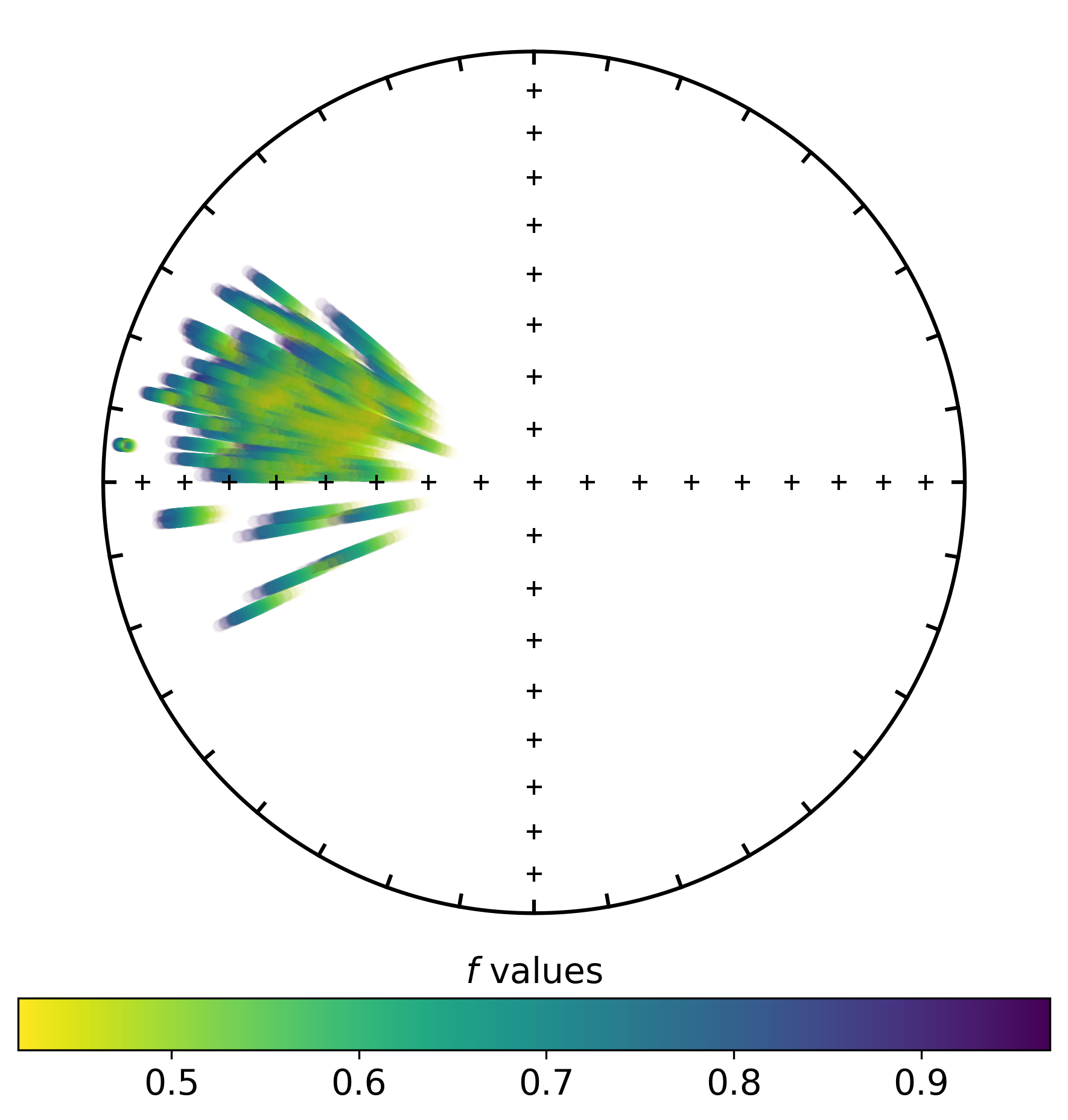 Quantifying Inclination Shallowing and Representing Flattening Uncertainty in Sedimentary Paleomagnetic PolesPierce, James, Zhang, Yiming, Hodgin, Eben B., and Swanson-Hysell, Nicholas L.Geochemistry, Geophysics, Geosystems Sep 2022
Quantifying Inclination Shallowing and Representing Flattening Uncertainty in Sedimentary Paleomagnetic PolesPierce, James, Zhang, Yiming, Hodgin, Eben B., and Swanson-Hysell, Nicholas L.Geochemistry, Geophysics, Geosystems Sep 2022@article{Pierce2022b, author = {Pierce, James and Zhang, Yiming and Hodgin, Eben B. and Swanson-Hysell, Nicholas L.}, date-added = {2022-11-26 22:26:36 -0800}, date-modified = {2025-03-04 12:08:42 -0600}, doi = {10.1029/2022gc010682}, journal = {Geochemistry, Geophysics, Geosystems}, number = {11}, publisher = {American Geophysical Union ({AGU})}, title = {Quantifying Inclination Shallowing and Representing Flattening Uncertainty in Sedimentary Paleomagnetic Poles}, url = {https://doi.org/10.1029%2F2022gc010682}, volume = {23}, year = {2022}, bdsk-url-1 = {https://doi.org/10.1029%2F2022gc010682}, bdsk-url-2 = {https://doi.org/10.1029/2022gc010682} } -
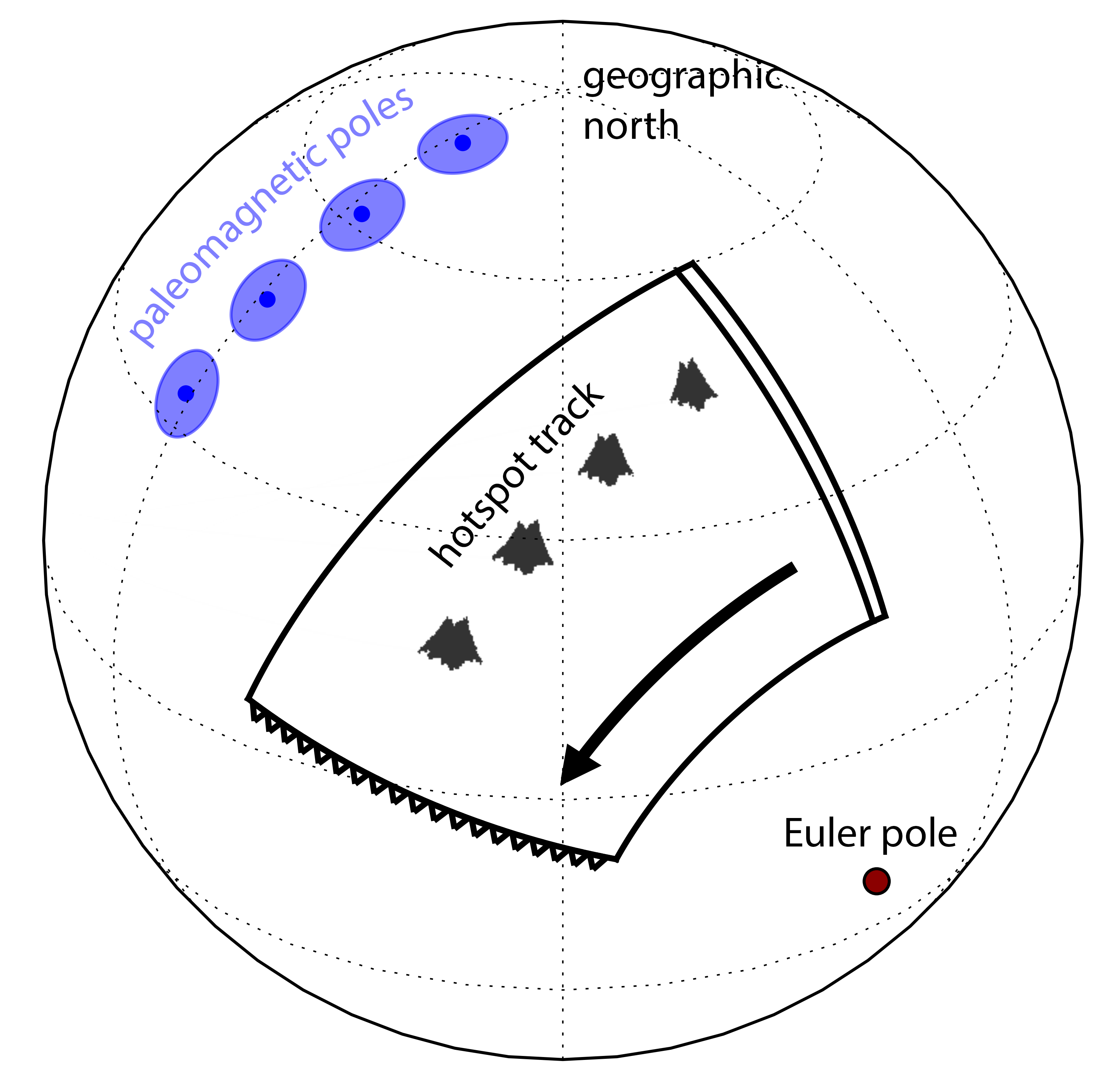 Bayesian paleomagnetic Euler pole inversion for paleogeographic reconstruction and analysisRose, Ian R., Zhang, Yiming, and Swanson-Hysell, Nicholas L.Journal of Geophysical Research: Solid Earth Sep 2022
Bayesian paleomagnetic Euler pole inversion for paleogeographic reconstruction and analysisRose, Ian R., Zhang, Yiming, and Swanson-Hysell, Nicholas L.Journal of Geophysical Research: Solid Earth Sep 2022@article{Rose2022a, author = {Rose, Ian R. and Zhang, Yiming and Swanson-Hysell, Nicholas L.}, date-added = {2022-09-27 12:38:34 -0700}, date-modified = {2025-03-04 12:08:31 -0600}, doi = {10.1029/2021jb023890}, journal = {Journal of Geophysical Research: Solid Earth}, publisher = {American Geophysical Union ({AGU})}, title = {Bayesian paleomagnetic Euler pole inversion for paleogeographic reconstruction and analysis}, url = {https://doi.org/10.1029%2F2021jb023890}, year = {2022}, bdsk-file-1 = {YnBsaXN0MDDSAQIDBFxyZWxhdGl2ZVBhdGhYYm9va21hcmtfED0uLi8uLi9saXRlcmF0dXJlL1Jvc2UyMDIyYUJheWVzaWFuIHBhbGVvbWFnbmV0aWMgRXVsZXIgcGMucGRmTxEETGJvb2tMBAAAAAAEEDAAAAAAAAAAAAAAAAAAAAAAAAAAAAAAAAAAAAAAAAAAAAAAADwDAAAFAAAAAQEAAFVzZXJzAAAACwAAAAEBAAB5aW1pbmd6aGFuZwAGAAAAAQEAAEdpdGh1YgAACgAAAAEBAABsaXRlcmF0dXJlAAAsAAAAAQEAAFJvc2UyMDIyYUJheWVzaWFuIHBhbGVvbWFnbmV0aWMgRXVsZXIgcGMucGRmFAAAAAEGAAAEAAAAFAAAACgAAAA4AAAATAAAAAgAAAAEAwAAIkIAAAAAAAAIAAAABAMAAJheAAAAAAAACAAAAAQDAAAj+AoAAAAAAAgAAAAEAwAA9sYMAAAAAAAIAAAABAMAAC+KEAAAAAAAFAAAAAEGAACcAAAArAAAALwAAADMAAAA3AAAAAgAAAAABAAAQcR6dQ+AAAAYAAAAAQIAAAEAAAAAAAAADwAAAAAAAAAAAAAAAAAAAAgAAAAEAwAAAwAAAAAAAAAEAAAAAwMAAPUBAAAIAAAAAQkAAGZpbGU6Ly8vDAAAAAEBAABNYWNpbnRvc2ggSEQIAAAABAMAAACQgpbnAAAACAAAAAAEAABBxyiEhoAAACQAAAABAQAANDlENkUxMDMtMjFFMy00OEY2LUExQUYtQzQxNjZGNzc1NDhFGAAAAAECAACBAAAAAQAAAO8TAAABAAAAAAAAAAAAAAABAAAAAQEAAC8AAAAAAAAAAQUAAAMBAAABAgAAZDY4OTdiNmExZjZhMTJmY2IxYmYzOGQxNDg0MDBlYzY3YzJhODZkNjE4MWYzODEwZGJhYmU3ZGY1YjQ4YzYwOTswMDswMDAwMDAwMDswMDAwMDAwMDswMDAwMDAwMDswMDAwMDAwMDAwMDAwMDIwO2NvbS5hcHBsZS5hcHAtc2FuZGJveC5yZWFkLXdyaXRlOzAxOzAxMDAwMDBkOzAwMDAwMDAwMDAxMDhhMmY7MDE7L3VzZXJzL3lpbWluZ3poYW5nL2dpdGh1Yi9saXRlcmF0dXJlL3Jvc2UyMDIyYWJheWVzaWFuIHBhbGVvbWFnbmV0aWMgZXVsZXIgcGMucGRmAAAvAAAAAQEAAE5TVVJMQm9va21hcmtRdWFyYW50aW5lTW91bnRlZE5ldHdvcmtWb2x1bWVzS2V5ANgAAAD+////AQAAAAAAAAARAAAABBAAAIAAAAAAAAAABRAAAOwAAAAAAAAAEBAAABgBAAAAAAAAQBAAAAgBAAAAAAAAAiAAAOQBAAAAAAAABSAAAFQBAAAAAAAAECAAAGQBAAAAAAAAESAAAJgBAAAAAAAAEiAAAHgBAAAAAAAAEyAAAIgBAAAAAAAAICAAAMQBAAAAAAAAMCAAAPABAAAAAAAAAcAAADgBAAAAAAAAEcAAABQAAAAAAAAAEsAAAEgBAAAAAAAAgPAAAPgBAAAAAAAABAMAgPABAAAAAAAAAAgADQAaACMAYwAAAAAAAAIBAAAAAAAAAAUAAAAAAAAAAAAAAAAAAASz} } -
 High geomagnetic field intensity recorded by anorthosite xenoliths requires a strongly powered late Mesoproterozoic geodynamoZhang, Yiming, Swanson-Hysell, Nicholas L., Avery, Margaret S., and Fu, Roger R.Proceedings of the National Academy of Sciences Sep 2022
High geomagnetic field intensity recorded by anorthosite xenoliths requires a strongly powered late Mesoproterozoic geodynamoZhang, Yiming, Swanson-Hysell, Nicholas L., Avery, Margaret S., and Fu, Roger R.Proceedings of the National Academy of Sciences Sep 2022@article{Zhang2022a, author = {Zhang, Yiming and Swanson-Hysell, Nicholas L. and Avery, Margaret S. and Fu, Roger R.}, date-added = {2022-07-11 12:26:29 -0700}, date-modified = {2025-03-04 12:06:13 -0600}, doi = {10.1073/pnas.2202875119}, journal = {Proceedings of the National Academy of Sciences}, number = {29}, pages = {e2202875119}, title = {High geomagnetic field intensity recorded by anorthosite xenoliths requires a strongly powered late Mesoproterozoic geodynamo}, url = {https://www.pnas.org/doi/abs/10.1073/pnas.2202875119}, volume = {119}, year = {2022}, bdsk-url-1 = {https://www.pnas.org/doi/abs/10.1073/pnas.2202875119}, bdsk-url-2 = {https://doi.org/10.1073/pnas.2202875119} } -
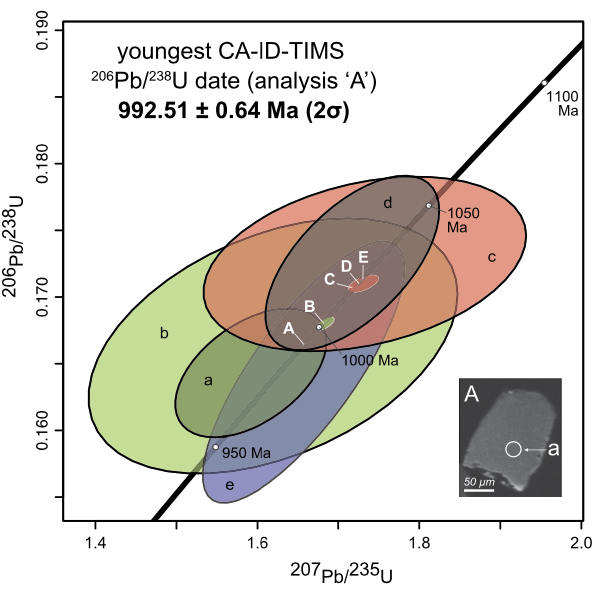 Final inversion of the Midcontinent Rift during the Rigolet Phase of the Grenvillian OrogenyHodgin, Eben B., Swanson-Hysell, Nicholas L., DeGraff, James M., Kylander-Clark, Andrew R.C., Schmitz, Mark D., Turner, Andrew C., Zhang, Yiming, and Stolper, Daniel A.Geology Sep 2022
Final inversion of the Midcontinent Rift during the Rigolet Phase of the Grenvillian OrogenyHodgin, Eben B., Swanson-Hysell, Nicholas L., DeGraff, James M., Kylander-Clark, Andrew R.C., Schmitz, Mark D., Turner, Andrew C., Zhang, Yiming, and Stolper, Daniel A.Geology Sep 2022@article{Hodgin2022a, author = {Hodgin, Eben B. and Swanson-Hysell, Nicholas L. and DeGraff, James M. and Kylander-Clark, Andrew R.C. and Schmitz, Mark D. and Turner, Andrew C. and Zhang, Yiming and Stolper, Daniel A.}, date-added = {2022-03-25 11:15:48 -0700}, date-modified = {2025-03-04 12:09:30 -0600}, doi = {10.1130/g49439.1}, journal = {Geology}, publisher = {Geological Society of America}, title = {Final inversion of the Midcontinent Rift during the Rigolet Phase of the Grenvillian Orogeny}, url = {https://doi.org/10.1130%2Fg49439.1}, year = {2022}, bdsk-url-1 = {https://doi.org/10.1130%2Fg49439.1}, bdsk-url-2 = {https://doi.org/10.1130/g49439.1} }
2021
-
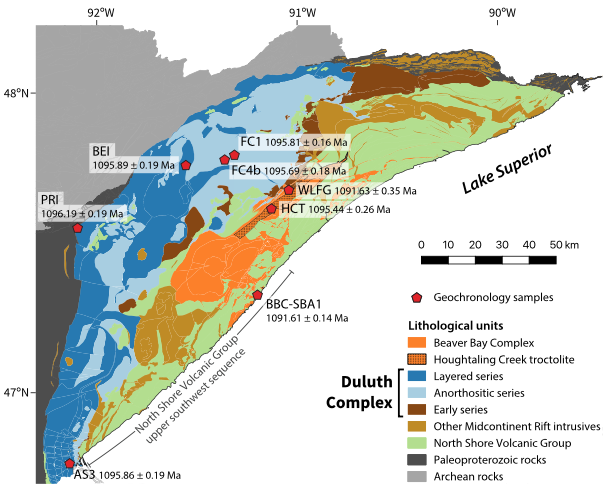 Rapid emplacement of massive Duluth Complex intrusions within the North American Midcontinent RiftSwanson-Hysell, Nicholas L., Hoaglund, Steven A., Crowley, James L., Schmitz, Mark D., Zhang, Yiming, and Miller, James D.Geology Sep 2021
Rapid emplacement of massive Duluth Complex intrusions within the North American Midcontinent RiftSwanson-Hysell, Nicholas L., Hoaglund, Steven A., Crowley, James L., Schmitz, Mark D., Zhang, Yiming, and Miller, James D.Geology Sep 2021@article{Swanson-Hysell2021a, author = {Swanson-Hysell, Nicholas L. and Hoaglund, Steven A. and Crowley, James L. and Schmitz, Mark D. and Zhang, Yiming and Miller, James D.}, date-added = {2020-09-25 09:16:13 -0700}, date-modified = {2025-03-04 12:10:30 -0600}, doi = {10.1130/g47873.1}, journal = {Geology}, publisher = {Geological Society of America}, title = {Rapid emplacement of massive Duluth Complex intrusions within the North American Midcontinent Rift}, url = {https://doi.org/10.1130%2Fg47873.1}, year = {2021}, bdsk-url-1 = {https://doi.org/10.1130%2Fg47873.1}, bdsk-url-2 = {https://doi.org/10.1130/g47873.1} } -
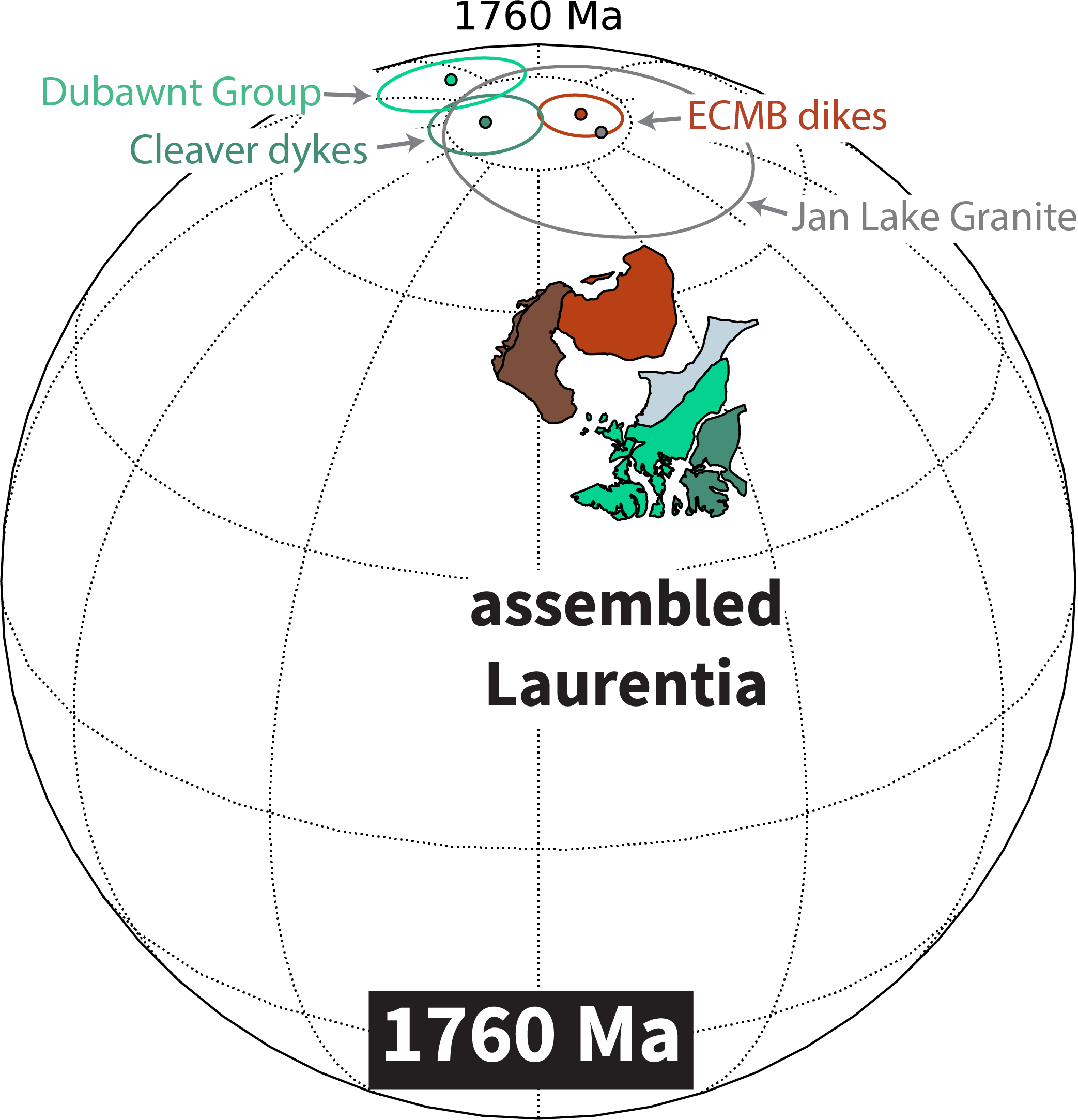 The paleogeography of Laurentia in its early years:new constraints from the Paleoproterozoic East-Central Minnesota batholithSwanson-Hysell, Nicholas L., Avery, Margaret S., Zhang, Yiming, Hodgin, Eben B., Sherwood, Robert J., Apen, Francisco E., Boerboom, Terrence J., Keller, C. Brenhin, and Cottle, John M.Tectonics Sep 2021
The paleogeography of Laurentia in its early years:new constraints from the Paleoproterozoic East-Central Minnesota batholithSwanson-Hysell, Nicholas L., Avery, Margaret S., Zhang, Yiming, Hodgin, Eben B., Sherwood, Robert J., Apen, Francisco E., Boerboom, Terrence J., Keller, C. Brenhin, and Cottle, John M.Tectonics Sep 2021@article{Swanson-Hysell2021b, author = {Swanson-Hysell, Nicholas L. and Avery, Margaret S. and Zhang, Yiming and Hodgin, Eben B. and Sherwood, Robert J. and Apen, Francisco E. and Boerboom, Terrence J. and Keller, C. Brenhin and Cottle, John M.}, date-added = {2021-04-23 09:34:34 -0700}, date-modified = {2025-03-04 12:06:58 -0600}, doi = {10.1029/2021tc006751}, journal = {Tectonics}, publisher = {American Geophysical Union ({AGU})}, title = {{The paleogeography of Laurentia in its early years:new constraints from the Paleoproterozoic East-Central Minnesota batholith}}, url = {https://doi.org/10.1029%2F2021tc006751}, year = {2021}, bdsk-url-1 = {https://doi.org/10.1029%2F2021tc006751}, bdsk-url-2 = {https://doi.org/10.1029/2021tc006751} } -
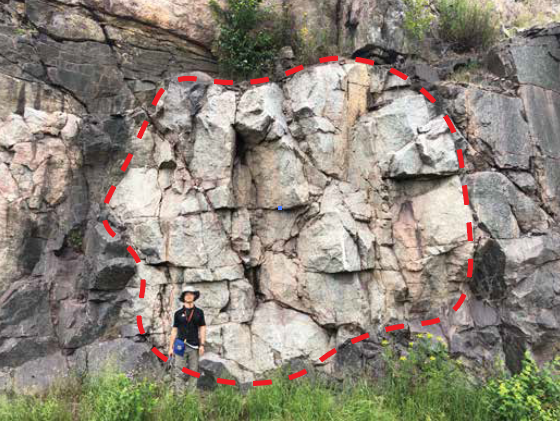 Synchronous emplacement of the anorthosite xenolith-bearing Beaver River diabase and one of the largest lava flows on EarthZhang, Yiming, Swanson-Hysell, Nicholas L., Schmitz, Mark D., Miller, James D., and Avery, Margaret S.Geochemistry, Geophysics, Geosystems Sep 2021
Synchronous emplacement of the anorthosite xenolith-bearing Beaver River diabase and one of the largest lava flows on EarthZhang, Yiming, Swanson-Hysell, Nicholas L., Schmitz, Mark D., Miller, James D., and Avery, Margaret S.Geochemistry, Geophysics, Geosystems Sep 2021@article{Zhang2021b, author = {Zhang, Yiming and Swanson-Hysell, Nicholas L. and Schmitz, Mark D. and Miller, James D. and Avery, Margaret S.}, date-added = {2021-09-23 17:28:50 -0700}, date-modified = {2025-03-04 12:06:35 -0600}, doi = {10.1029/2021gc009909}, journal = {Geochemistry, Geophysics, Geosystems}, publisher = {American Geophysical Union ({AGU})}, title = {{Synchronous emplacement of the anorthosite xenolith-bearing Beaver River diabase and one of the largest lava flows on Earth}}, url = {https://doi.org/10.1029%2F2021gc009909}, year = {2021}, bdsk-url-1 = {https://doi.org/10.1029%2F2021gc009909}, bdsk-url-2 = {https://doi.org/10.1029/2021gc009909} } -
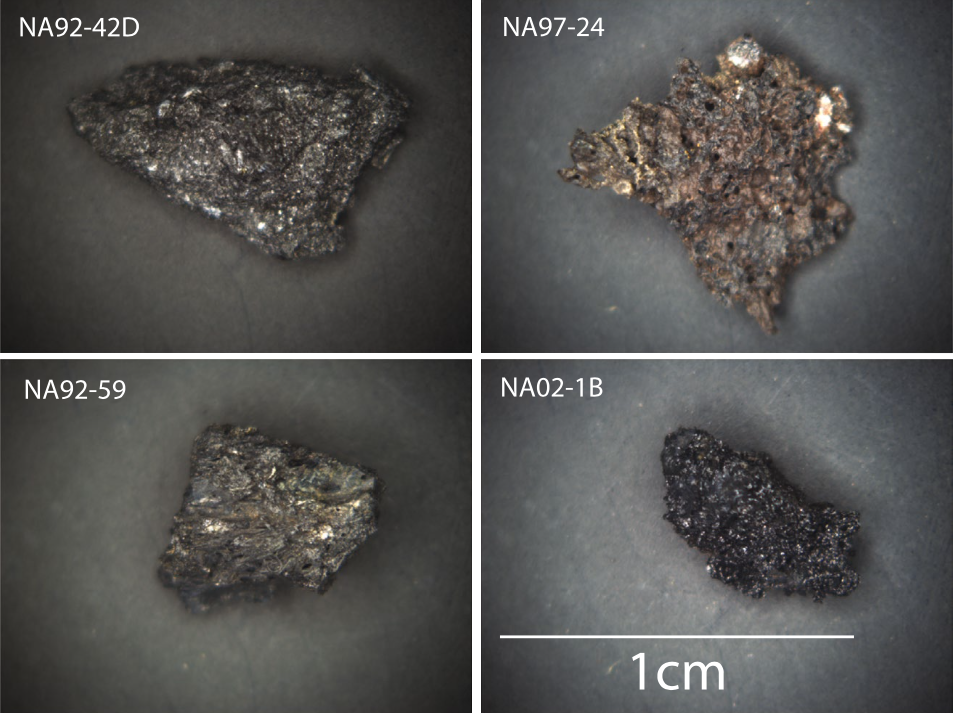 New paleointensity data from Aniakchak volcano, Alaska, USACromwell, Geoffrey, and Zhang, YimingGeochemistry, Geophysics, Geosystems Sep 2021
New paleointensity data from Aniakchak volcano, Alaska, USACromwell, Geoffrey, and Zhang, YimingGeochemistry, Geophysics, Geosystems Sep 2021@article{Cromwell2021a, author = {Cromwell, Geoffrey and Zhang, Yiming}, date-added = {2021-11-02 18:21:07 -0700}, date-modified = {2025-03-04 12:09:49 -0600}, doi = {10.1029/2021gc010032}, journal = {Geochemistry, Geophysics, Geosystems}, publisher = {American Geophysical Union ({AGU})}, title = {New paleointensity data from Aniakchak volcano, Alaska, {USA}}, url = {https://doi.org/10.1029%2F2021gc010032}, year = {2021}, bdsk-url-1 = {https://doi.org/10.1029%2F2021gc010032}, bdsk-url-2 = {https://doi.org/10.1029/2021gc010032} }